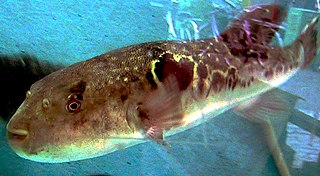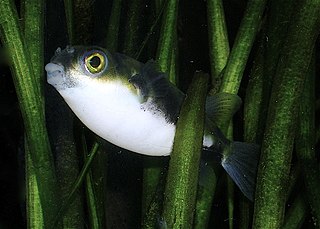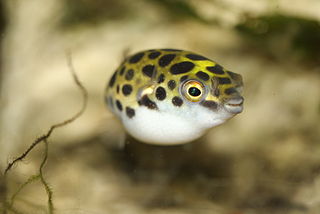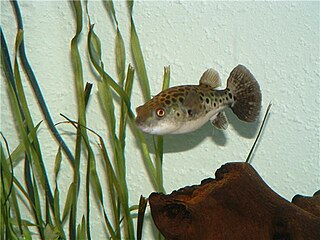
Tetraodontidae is a family of primarily marine and estuarine fish of the order Tetraodontiformes. The family includes many familiar species variously called pufferfish, puffers, balloonfish, blowfish, blowers, blowies, bubblefish, globefish, swellfish, toadfish, toadies, toadle, honey toads, sugar toads, and sea squab. They are morphologically similar to the closely related porcupinefish, which have large external spines. The scientific name refers to the four large teeth, fused into an upper and lower plate, which are used for crushing the hard shells of crustaceans and mollusks, their natural prey.

Takifugu, also known by the Japanese name fugu, is a genus of pufferfish with 25 species, most of which are native to salt and brackish waters of the northwest Pacific, but a few species are found in freshwater in Asia or more widely in the Indo-Pacific region. Their diet consists mostly of algae, molluscs, invertebrates and sometimes crustaceans.

Stegastes is a genus of ray-finned fish in the family Pomacentridae. Members of this genus are marine coastal fishes except for S. otophorus, which also occurs in brackish water. These fish are known by the names of damselfish, gregory and major. They are small tropical fish associated with coral and rocky reefs in the Atlantic, Indian and Pacific Oceans. They are sometimes found in the aquarium trade where they are an easy-to-keep fish, but they do not mix well with other fish of their own or other species because of their territorial habits and aggressiveness.

Colomesus is a genus of pufferfishes confined to tropical South America. Apart from differences in size, the three species are superficially similar, being green above, white below, and patterned with black transverse bands across the dorsal surface. C. asellus is commonly found in the aquarium trade, while C. psittacus, due to its size and more specialized requirements, is not found as often.

Carinotetraodon is a polyphyletic genus of small freshwater pufferfish found in South and Southeast Asia.Several species have commercial importance as aquarium fish.

Dichotomyctere ocellatus, commonly the figure 8 puffer or eyespot puffer, is a pufferfish found in freshwater in Southeast Asia. It is known from the lower reaches of the Mekong (Cambodia), the Peninsular Malaysia as well as Borneo.

Dichotomyctere nigroviridis is one of the pufferfish known as the green spotted puffer. It is found across South and Southeast Asia in coastal freshwater,but survives the longest in brackish to saltwater, and brackish water habitats. D. nigroviridis reaches a typical maximum length of about 15 cm (6 in) (5.9 in), with reports of up to 17 cm (6.7 in). In February 2009, it was successfully bred in captivity at University of Florida using a new variation of the ovarian lavage technique.

The dwarf pufferfish, also known as the Malabar pufferfish, pygmy pufferfish, or pea pufferfish, is a small freshwater pufferfish endemic to Kerala and southern Karnataka in Southwest India. They are popular in aquaria for their bright colours and small size. At a maximum length of 3.5 cm, dwarf pufferfish are one of the smallest pufferfish in the world. They closely resemble the related Carinotetraodon imitator, and the two can be difficult to distinguish. C. imitator was not recognised as a different species until 1999.

Colomesus psittacus, the Banded puffer, parrot puffer or South American estuarine puffer, is a species of pufferfish found all along the Western Atlantic coastline of South America from the Gulf of Paria down to the mouth of the Amazon River in Brazil.

Carinotetraodon irrubesco, known commonly as the red-tail dwarf puffer, is a freshwater pufferfish found only in the lower Banyuasin basin in South Sumatra and the Sambas River in West Kalimantan.

The grass puffer, or Kusa-fugu, is a species of fish in the pufferfish family (Tetraodontidae). This common to abundant species is found in the northwest Pacific Ocean in China, Japan, Korea, the Philippines and Vietnam. It is primarily found in coastal waters, ranging to depths of 20 m (66 ft), but is often seen in brackish water and has also been recorded briefly entering freshwater. The grass puffer reaches up to 15 cm (6 in) in length.

The green pufferfish or Ceylon pufferfish is a species of pufferfish found in South and Southeast Asia. Its habitat includes rivers, estuaries, lakes and flood plains. It lives in fresh to slightly brackish water.
Pao leiurus is a species of pufferfish found in Southeast Asia from Thailand to Indonesia and in particular the Mekong basin. It is occasionally imported into the aquarium trade but is reported to be aggressive and snappish.

Dichotomyctere sabahensis is a species of pufferfish endemic to the southeast Asian island of Borneo. This species grows to a standard length of 10.8 cm (4.3 in).

Auriglobus is a genus of freshwater pufferfishes native to Southeast Asia. They generally resemble Chonerhinos, but are considerably smaller, only reaching up to 13 cm (5.1 in) in length, and are more strongly associated with freshwater. The different Auriglobus species are very similar in appearance — greenish-golden or yellowish-golden above and pale below — but can be separated by morphometrics and meristics. Until 1999, the Auriglobus species were included in Chonerhinos.
Pao turgidus is a species of freshwater pufferfish native to the Mekong basin. It may also occur in the Chao Phraya basin in Thailand. This species grows to a length of 18.5 centimetres (7.3 in) SL.

Carinotetraodonborneensis, sometimes known as the Bornean red-eye puffer, is a species of pufferfish in the family Tetraodontidae. It is a tropical freshwater species known only from southern Sarawak, Malaysia. It reaches 4.4 cm SL and is sometimes seen in the aquarium trade.
Carinotetraodon salivator, also known as the striped red-eye puffer, is a species of freshwater pufferfish in the family Tetraodontidae. It is a tropical species known only from Sarawak, Malaysian Borneo, where it occurs at a depth range of 1 to 2 m. It is found in large, fast-flowing streams with silty and sandy bottoms, leaf litter, and submerged logs. It reaches 4 cm (1.6 in) standard length and is occasionally seen in the aquarium trade.

Takifugu ocellatus, sometimes known as the ocellated puffer or the orange-saddle puffer, is a species of anadromous pufferfish in the family Tetraodontidae. It is native to China and Vietnam. Juveniles of the species occur in brackish and freshwater environments, but adults are marine. This species is noted to be fatally poisonous to humans if consumed. It reaches 15 cm in total length.















